oil TOYOTA 86 2019 Owners Manual
[x] Cancel search | Manufacturer: TOYOTA, Model Year: 2019, Model line: 86, Model: TOYOTA 86 2019Pages: 532, PDF Size: 6.89 MB
Page 5 of 532

1
2
3
4
5
6
7
55-2. Steps to take in an
emergency
If a warning light turns on
or a warning buzzer
sounds... ........................... 395
If a warning message is
displayed........................... 407
If you have a flat tire............ 424
If the engine will not start .... 435
If the shift lever cannot be
shifted from P.................... 438
If you lose your keys ........... 439
If the electronic key does
not operate properly.......... 440
If the battery is
discharged ........................ 444
If your vehicle overheats ..... 449
If the vehicle becomes
stuck ................................. 452
If your vehicle has to be
stopped in an
emergency ........................ 454 6-1. Specifications
Maintenance data
(fuel, oil level, etc.) ........... 458
Fuel information.................. 470
Tire information .................. 474
6-2. Customization
Customizable features........ 487
Reporting safety defects
for U.S. owners ................ 492
Seat belt instructions
for Canadian owners
(in French) ........................ 493
SRS airbag instructions
for Canadian owners
(in French) ........................ 496
Abbreviation list ........................ 520
Alphabetical index .................... 521
What to do if... .......................... 529 6
Vehicle specifications
7
For owners
Index
Page 31 of 532

311-2. Opening, closing and locking the doors and trunk
1
Before driving ■ Conditions affecting operation
The smart key system uses weak radio waves. In the following si tuations,
the communication between the electronic key and the vehicle ma y be
affected, preventing the smart key system, wireless remote control and
engine immobilizer system from operating properly.
(Way of coping P. 440)
● When the electronic key battery is depleted
● Near a TV tower, electric power plant, gas station, radio stati on, large dis-
play, airport or other facility that generates strong radio wav es or electri-
cal noise
● When the electronic key is in contact with, or is covered by th e following
metallic objects
• Cards to which aluminum foil is attached
• Cigarette boxes that have aluminum foil inside
• Metallic wallets or bags
• Coins
• Hand warmers made of metal
• Media such as CDs and DVDs
● When other wireless keys (that emit radio waves) are being used nearby
● When carrying the electronic key together with the following de vices that
emit radio waves
• A portable radio, cellular phone, cordless phone or other wire less com-
munication device
• Another vehicle's electronic key or a wireless key that emits radio
waves
• Personal computers or personal digital assistants (PDAs)
• Digital audio players
• Portable game systems
● If window tint with a metallic content or metallic objects are attached to
the rear window
● When the electronic key is placed near a battery charger or electronic
devices
Page 51 of 532
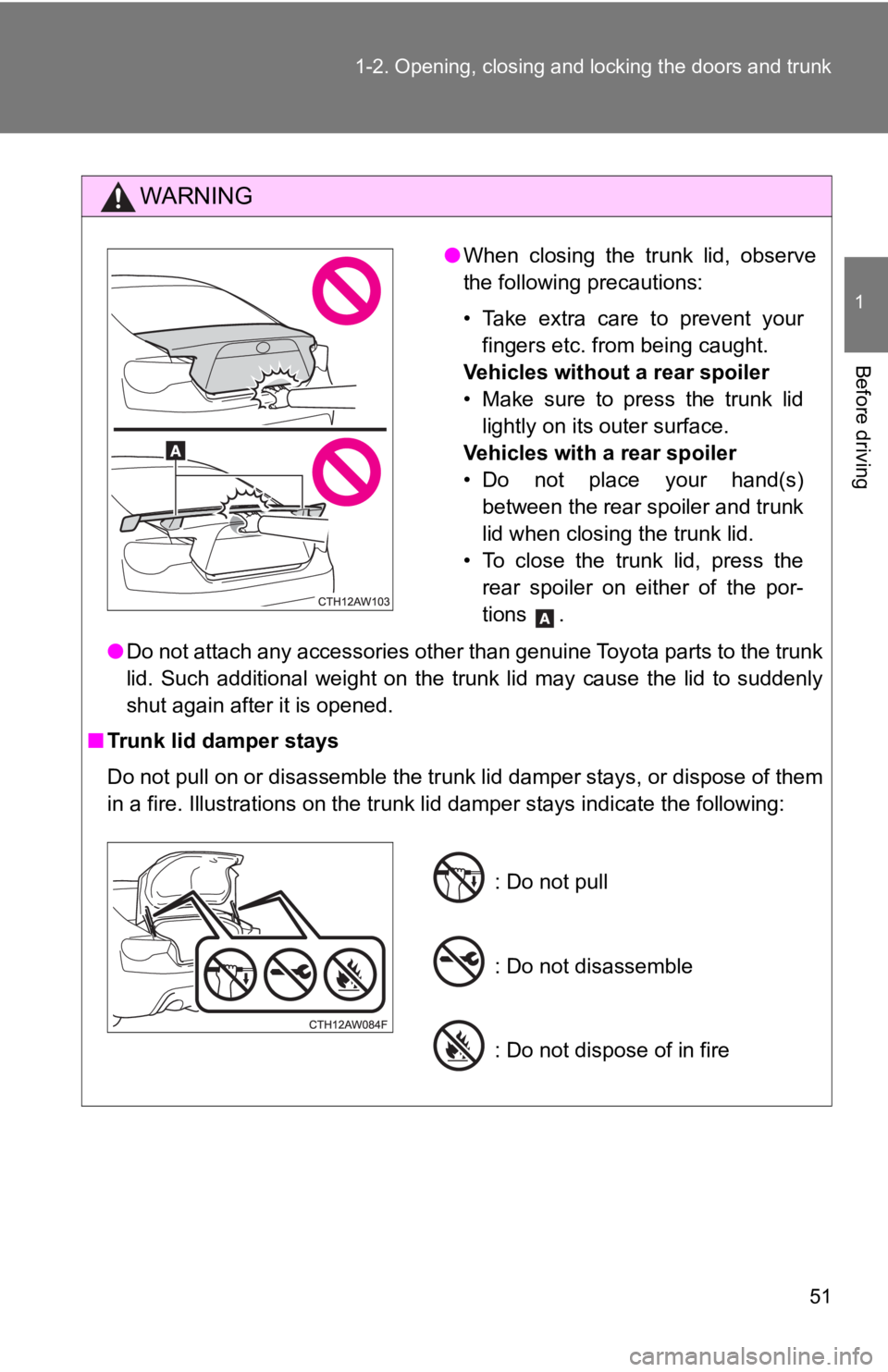
511-2. Opening, closing and locking the doors and trunk
1
Before driving WARNING
● Do not attach any accessories other than genuine Toyota parts t o the trunk
lid. Such additional weight on the trunk lid may cause the lid to suddenly
shut again after it is opened.
■ Trunk lid damper stays
Do not pull on or disassemble the trunk lid damper stays, or di spose of them
in a fire. Illustrations on the trunk lid damper stays indicate the following:● When closing the trunk lid, observe
the following precautions:
• Take extra care to prevent your
fingers etc. from being caught.
Vehicles without a rear spoiler
• Make sure to press the trunk lid
lightly on its outer surface.
Vehicles with a rear spoiler
• Do not place your hand(s)
between the rear spoiler and trunk
lid when closing the trunk lid.
• To close the trunk lid, press the
rear spoiler on either of the por-
tions .
: Do not pull
: Do not disassemble
: Do not dispose of in fire
Page 165 of 532

1652-1. Driving procedures
2
When driving NOTICE■ Avoiding damage to vehicle parts
● Do not turn the steering wheel fully in either direction and ho ld it there for
an extended period of time.
Doing so may damage the power steering motor.
● When driving over bumps in the road, drive as slowly as possibl e to avoid
damaging the wheels, underside of the vehicle, etc.
● On vehicles with an automatic transmission, do not race the eng ine for
more than 5 seconds in any position except the N or P position when the
brake is applied or when chocks are used in the wheels. This ma y cause
the transmission fluid to overheat.
■ If you get a flat tire while driving
A flat or damaged tire may cause the following situations. Hold the steering
wheel firmly and gradually depress the brake pedal to slow down the vehicle.
● It may be difficult to control your vehicle.
● The vehicle will make abnormal sounds or vibrations.
● The vehicle will lean abnormally.
Information on what to do in case of a flat tire ( P. 424)
■ When encountering flooded roads
Do not drive on a road that has flooded after heavy rain etc. D oing so may
cause the following serious damage to the vehicle:
● Engine stalling
● Short in electrical components
● Engine damage caused by water immersion
In the event that you drive on a flooded road and the vehicle i s flooded, be
sure to have your Toyota dealer check the following:
● Brake function
● Changes in quantity and quality of oil and fluid used for the e ngine, trans-
mission, differential, etc.
● Lubricant condition for the propeller shaft, bearings and suspension joints
(where possible) and the function of all joints, bearings, etc.
Page 182 of 532

1822-1. Driving procedures
● When engine oil temperature is high and engine speed rises clos e
to the red zone.■ When moving the shift lever out of P
If the shift lever is pushed sideways before the brake pedal is depressed,
shift lever operation may not be possible. Depress the brake pe dal before
shifting the shift lever out of P.
■ Downshifting restrictions warning buzzer
If downshifting operations are performed at a vehicle speed by which down-
shifting is not possible (when downshifting will cause the engi ne speed to
enter the red zone), a buzzer will sound to warn the driver that downshifting
cannot be performed.
■ When driving with cruise control activated
Downshifting can be performed even when using cruise control. A fter down-
shifting, the set speed continues. ( P. 181, 183)
■ Sport mode
● In sport mode, lower gears are used and gears change at a highe r
engine speed.
● If sport mode is changed to while the shift lever is in the M p osition, the
“SPORT” indicator will come on but sport mode controls will not be car-
ried out. Shift the shift lever to the D position.
● Sport mode cannot be changed to when driving with cruise contro l acti-
vated.
■ Snow mode
To prevent slipping, 1 st
gear cannot be selected when in snow mode.
■ Sport mode and snow mode automatic deactivation
In the following situations, the driving mode is automatically deactivated:
● When the engine is turned off after driving in sport mode or sn ow mode.
● When cruise control is activated while driving in sport mode.
■ If the shift lever cannot be shifted from P
P. 438
Page 211 of 532
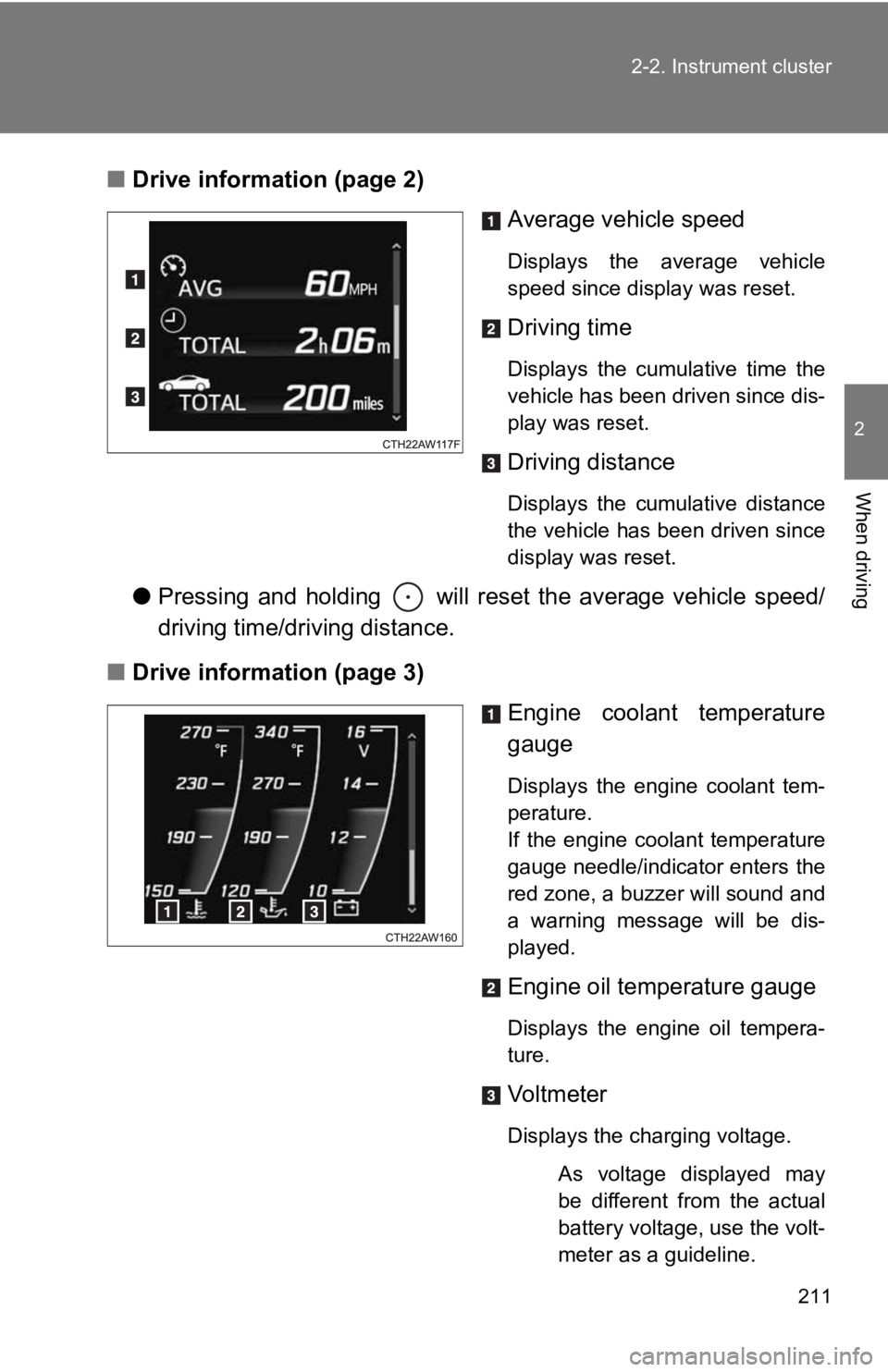
2112-2. Instrument cluster
2
When driving ■ Drive information (page 2)
Average vehicle speed Displays the average vehicle
speed since display was reset.
Driving time Displays the cumulative time the
vehicle has been driven since dis-
play was reset.
Driving distance Displays the cumulative distance
the vehicle has been driven since
display was reset.
● Pressing and holding will reset the average vehicle speed/
driving time/driving distance.
■ Drive information (page 3)
Engine coolant temperature
gauge Displays the engine coolant tem-
perature.
If the engine coolant temperature
gauge needle/indicator enters the
red zone, a buzzer will sound and
a warning message will be dis-
played.
Engine oil temperature gauge
Displays the engine oil tempera-
ture.
Vol tm et er
Displays the charging voltage.
As voltage displayed may
be different from the actual
battery voltage, use the volt-
meter as a guideline.
Page 261 of 532
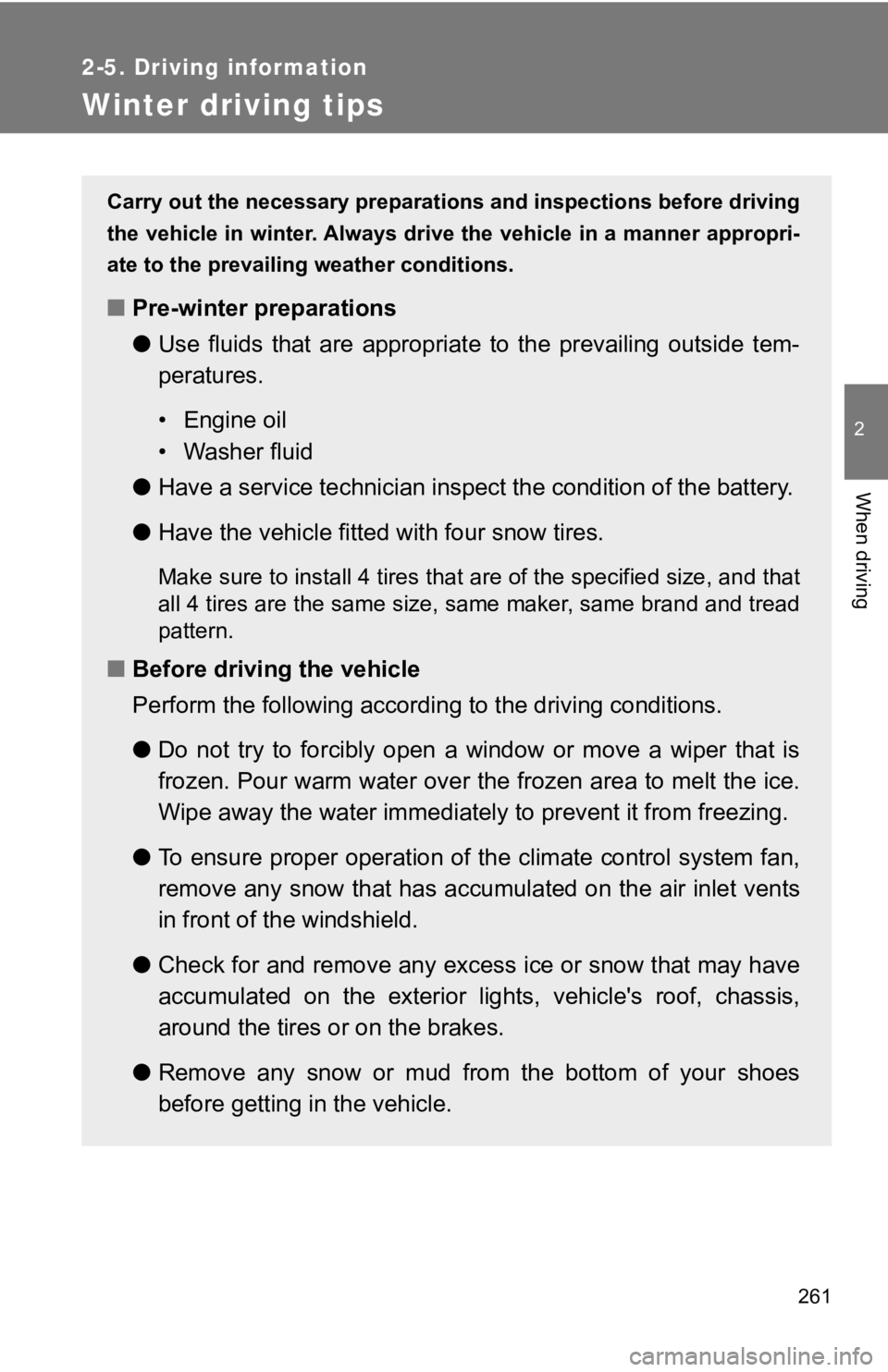
2612-5. Driving information
2
When driving
Winter driving tips Carry out the necessary preparatio ns and inspections before dri ving
the vehicle in winter. Always drive the vehicle in a manner app ropri-
ate to the prevailing weather conditions.
■ Pre-winter preparations
● Use fluids that are appropriate t o the prevailing outside tem-
peratures.
• Engine oil
• Washer fluid
● Have a service technician inspec t the condition of the battery.
● Have the vehicle fitted with four snow tires.
Make sure to install 4 tires that are of the specified size, an d that
all 4 tires are the same size, same maker, same brand and tread
pattern.
■ Before driving the vehicle
Perform the following accordi ng to the driving conditions.
● Do not try to forcibly open a window or move a wiper that is
frozen. Pour warm water over the frozen area to melt the ice.
Wipe away the water immediately to prevent it from freezing.
● To ensure proper operation of the climate control system fan,
remove any snow that has accumulated on the air inlet vents
in front of th e windshield.
● Check for and remove any excess ice or snow that may have
accumulated on the exterior lig hts, vehicle's roof, chassis,
around the tires or on the brakes.
● Remove any snow or mud from the bottom of your shoes
before getting in the vehicle.
Page 310 of 532
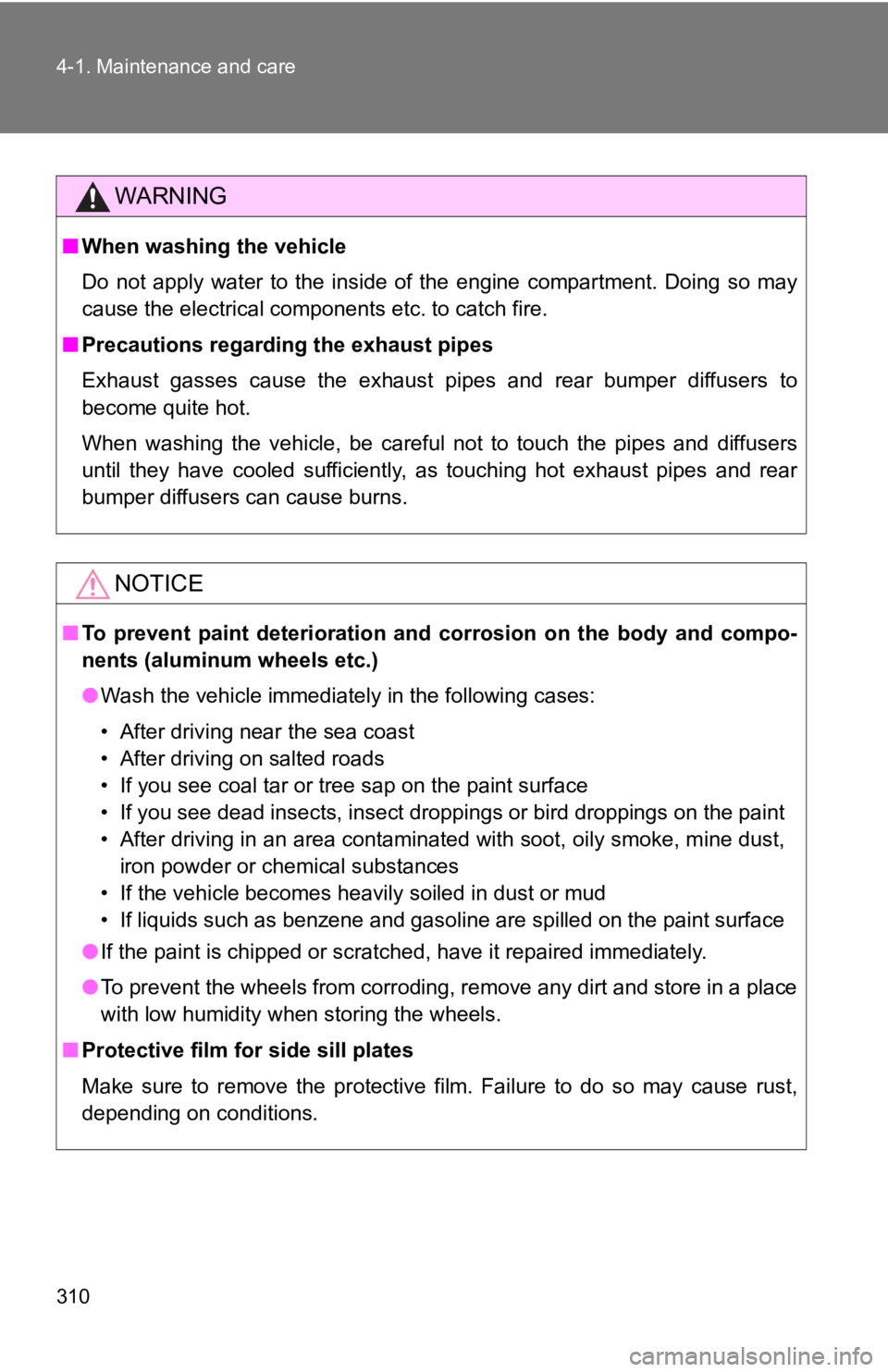
3104-1. Maintenance and care
WARNING■ When washing the vehicle
Do not apply water to the inside of the engine compartment. Doi ng so may
cause the electrical components etc. to catch fire.
■ Precautions regardin g the exhaust pipes
Exhaust gasses cause the exhaust pipes and rear bumper diffuser s to
become quite hot.
When washing the vehicle, be careful not to touch the pipes and diffusers
until they have cooled sufficiently, as touching hot exhaust pi pes and rear
bumper diffusers can cause burns.
NOTICE■ To prevent paint deterioration an d corrosion on the body and co mpo-
nents (aluminum wheels etc.)
● Wash the vehicle immediately in the following cases:
• After driving near the sea coast
• After driving on salted roads
• If you see coal tar or tree sap on the paint surface
• If you see dead insects, insect droppings or bird droppings on the paint
• After driving in an area contaminated with soot, oily smoke, m ine dust,
iron powder or chemical substances
• If the vehicle becomes heavily soiled in dust or mud
• If liquids such as benzene and gasoline are spilled on the paint surface
● If the paint is chipped or scratched, have it repaired immediat ely.
● To prevent the wheels from corroding, remove any dirt and store in a place
with low humidity when storing the wheels.
■ Protective film for side sill plates
Make sure to remove the protective film. Failure to do so may c ause rust,
depending on conditions.
Page 314 of 532

3144-1. Maintenance and care
NOTICE■ Cleaning detergents
● Do not use organic substances such as benzene or gasoline, acid ic or
alkaline solutions, dye, bleach or other detergent. Doing so may discolor
the vehicle interior or cause streaks or damage to painted surfaces.
● Do not use polish wax or polish cleaner. The instrument panel's or other
interior part’s painted surface may be damaged.
● Do not use a chemical agent containing silicone (highly-polymerized sili-
con compound) when cleaning any of the electrical appliances su ch as the
air conditioning, all switches and their surrounding areas.
If silicon (highly-polymerized silicon compound) contacts these compo-
nents, it may cause the electrical appliances to malfunction.
■ Preventing damage to leather surfaces
Observe the following precautions to avoid damage to and deteri oration of
leather surfaces.
● Remove any dust, dirt, sand, oil spots etc. on leather surfaces immedi-
ately.
● Do not expose the vehicle to direct sunlight for extended perio ds of time.
Park the vehicle in the shade, especially during summer.
● Do not place items made of vinyl, plastic, or that contain wax on the uphol-
stery, as they may stick to the leather surface if the vehicle interior heats
up significantly.
■ Water on the floor
Do not wash the vehicle floor with water.
Vehicle systems such as the audio system may be damaged if wate r comes
into contact with electrical components under the floor of the vehicle, and
may also cause the body to rust.
Page 317 of 532
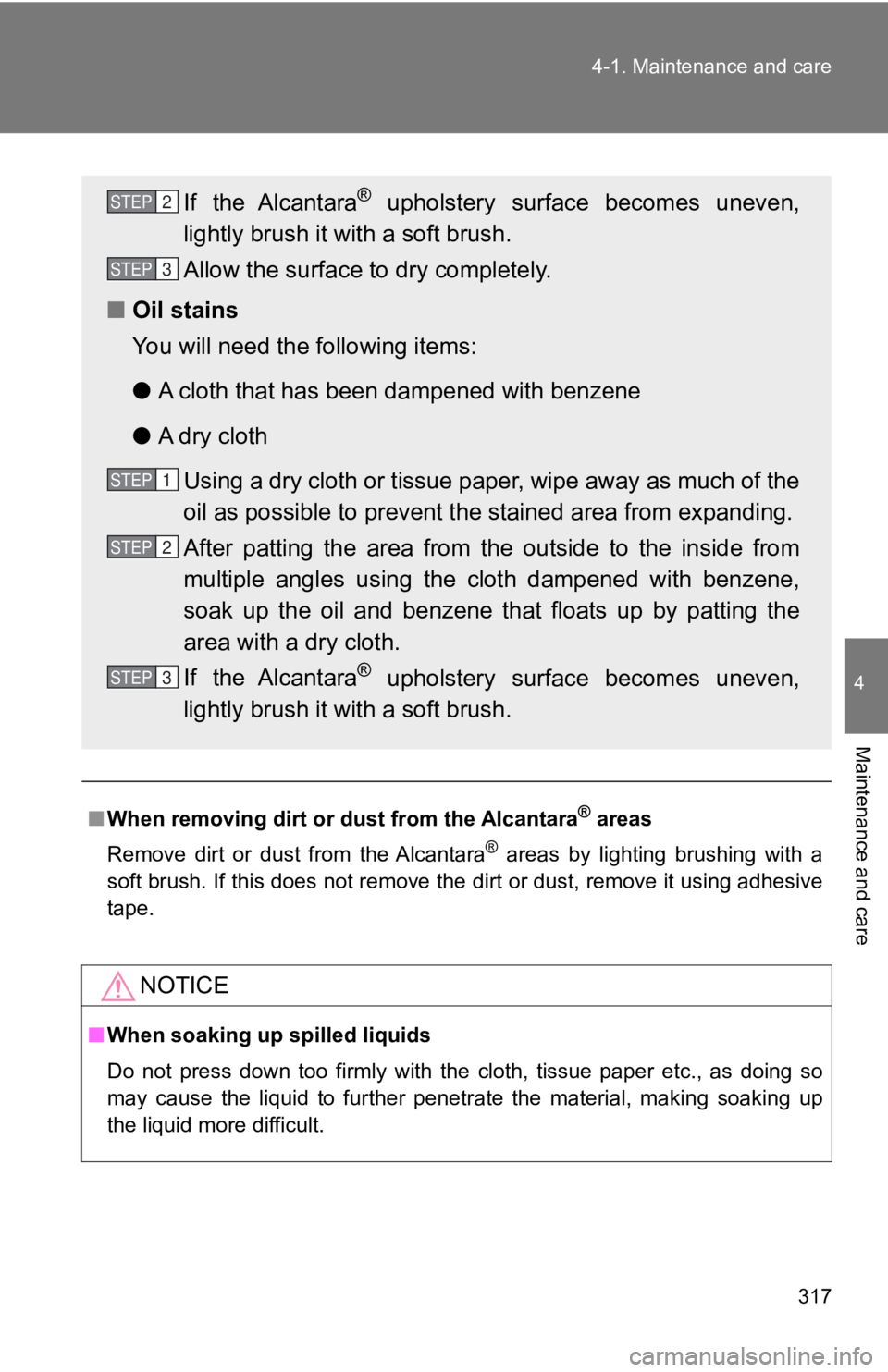
3174-1. Maintenance and care
4
Maintenance and care
■ When removing dirt or dust from the Alcantara ®
areas
Remove dirt or dust from the Alcantara ®
areas by lighting brushing with a
soft brush. If this does not remove the dirt or dust, remove it using adhesive
tape.
NOTICE
■ When soaking up spilled liquids
Do not press down too firmly with the cloth, tissue paper etc., as doing so
may cause the liquid to further penetrate the material, making soaking up
the liquid more difficult. If the Alcantara ®
upholstery surface becomes uneven,
lightly brush it with a soft brush.
Allow the surface to dry completely.
■ Oil stains
You will need the following items:
● A cloth that has bee n dampened with benzene
● A dry cloth
Using a dry cloth or tissue paper, wipe away as much of the
oil as possible to prevent t he stained area from expanding.
After patting the area from the outside to the inside from
multiple angles using the cloth dampened with benzene,
soak up the oil and benzene that floats up by patting the
area with a dry cloth.
If the Alcantara ®
upholstery surface becomes uneven,
lightly brush it with a soft brush.STEP 2
STEP 3
STEP 1
STEP 2
STEP 3